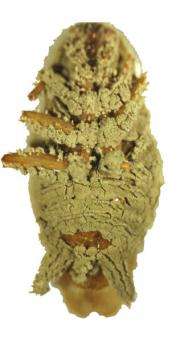June 22, 2012 report
Researchers find some plants get their nitrogen from fungi that kill insects

(Phys.org) -- We've all grown up with stories of plants that capture, kill and eat insects; the Venus fly trap the most notable example. Now it appears some plants get their nitrogen from insects via proxy. Instead of having to develop a complicated system of traps to catch insects on their own, they rely on fungi to do their dirty work for them. A team of Canadian researchers from Brock University, St. Catharine’s, has found that some plants, as they describe in their paper published in Science, grab nitrogen from fungi that live in its roots. The fungi get it from killing insects. In return for its generosity, the fungi get carbon.
After noting that a prior team of researchers had found that white pine trees got some of their nitrogen from fungus living in their roots that had obtained the nitrogen by killing springtails, the team wondered if perhaps many other plants did the same. To find out, they chose two random but common plants, haricot beans and switchgrass.
First they fed waxmoth larve a diet rich in a non-common type of nitrogen; nitrogen-15, so as to be able to distinguish it from the nitrogen that would normally be found in the plants. Next they infected the soil near the roots of the plants with Metarhizium, a very common type of fungi that is known to kill insects by releasing an enzyme that eats its way through the outer shell allowing the bug inside to be easily devoured. Then, they buried the infected larvae in the soil among the plant roots, along with a mesh to prevent the roots of the plants from reaching past the infected soil to soil that had been enriched with nitrogen through normal bacterial decomposition.
Two weeks later they tested the plants and found that the nitrogen in the beans was 28% nitrogen-15, and 32% in the switchgrass, proving that the plants had obtained at least some of their nitrogen from the fungi that had in turn got it from killing the enriched larvae. The chain was complete.
Because they used both common plants and fungi, the team believes their results show that such nitrogen chains: insects-fungi-plants, are likely very common. They say more research is needed however, to determine if the chain they created in the lab is just as prevalent in the wild.
More information: Endophytic Insect-Parasitic Fungi Translocate Nitrogen Directly from Insects to Plants, Science 22 June 2012: Vol. 336 no. 6088 pp. 1576-1577 DOI: 10.1126/science.1222289
ABSTRACT
Most plants obtain nitrogen through nitrogen-fixing bacteria and microbial decomposition of plant and animal material. Many vascular plants are able to form close symbiotic associations with endophytic fungi. Metarhizium is a common plant endophyte found in a large number of ecosystems. This abundant soil fungus is also a pathogen to a large number of insects, which are a source of nitrogen. It is possible that the endophytic capability and insect pathogenicity of Metarhizium are coupled to provide an active method of nitrogen transfer to plant hosts via fungal mycelia. We used soil microcosms to test the ability of M. robertsii to translocate insect-derived nitrogen to plants. Insects were injected with 15N-labeled nitrogen, and we tracked the incorporation of 15N into amino acids in two plant species, haricot bean (Phaseolus vulgaris) and switchgrass (Panicum virgatum), in the presence of M. robertsii. These findings are evidence that active nitrogen acquisition by plants in this tripartite interaction may play a larger role in soil nitrogen cycling than previously thought.
Journal information: Science
© 2012 Phys.Org
















